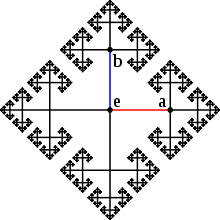As I said in my post about Hilbert's Hotel, one infinite hotel is just as good as two. This is because if you shuffle around the guests in both hotels, you can fit them into one hotel. Therefore, it should not be surprising that if you shuffle around the infinite number of points in a sphere, you can make two spheres out of them. What's surprising about the Banach-Tarski paradox is that there is a "nice" way of shuffling the points. Rather than moving each point individually, you can take entire sets of points and simply rotate them rigidly.
Let's say we have a ring of circumference 2π. I'm going to cut this ring into two pieces, rotate them around, and then make a new ring... with one point missing!
To choose the first piece, first take any point. Then move along the ring a length one, and take another point. Then move along the ring another length one (ie rotate by 1 radian), and take another point. Repeat infinitely. You know you will never end up back where you started because π is an irrational number. Instead, you will wrap around the ring an infinite number of times.
On the left, the first ten points are shown. On the right, the first two hundred are shown with progressively smaller dots.
If we rotate this piece around, we can send point 1 to point 2, point 2 to point 3, point 3 to point 4, and so on. This is exactly the same scenario as Hilbert's Hotel, where we told each guest to move to the next room over. We're left with the exact same set of points as before, but with point 1 missing.
So here's how you can remove a single point from the ring. First, cut the ring into two parts, one part described above, and the other containing all the leftover points. Then rotate one of the pieces by one radian. Then put the pieces back together.
Can we use a similar process--cutting the ring into a finite number of pieces, rotating them, and putting them back together--to make two rings out of one? Sadly, no. That's impossible.
However, spheres are much more complicated than rings. When you rotate a sphere, you can rotate it in any number of directions.
The set of points on the ring was "generated" by a point and a rotation. I just took a point, and then rotated it by a particular angle repeatedly. We can construct a set of points on the sphere in a very similar way, but using four rotations. The first two rotations are rotating clockwise and counter-clockwise around the z-axis by one radian. The other two rotations are the same, but around the y-axis.
The crucial fact about these rotations is that the order matters. If I rotate a point around the z-axis, and then the y-axis, then this will result in a different point than if I had rotated around the y-axis first, and then the z-axis.
When we constructed the set of points on the ring, I analogized it to an infinite row of rooms. Here, it would be better to analogize the points to a much more complicated arrangement of rooms, called the Cayley Graph.
The Cayley graph represents how all the different points are related by rotations. It does not represent how the points will actually look, because they'll wrapped around a spherical shell an infinite number of times. Image credit
The point at the center of the Cayley graph represents our initial starting point. From there, the graph splits up into four branches. The right branch is what you get if the last rotation was rotating clockwise around the z-axis. The upper branch is what you get if the last rotation was rotating clockwise around the y-axis. And so on.
The "paradox" occurs when we take the left branch and rotate it clockwise around the z-axis.
By simply rotating the left branch (in red), we get three branches (in blue). Together with the right branch, this makes the entire set. Similarly, we can take the upper branch and rotate it counter-clockwise around the y-axis, and get the upper three branches. Joined with the lower branch, we have a second copy of the set. Amazing! By cutting the set into four branches and rotating them around, I've made two copies of the set.
I'm leaving out a few details (like what happens with the center point), but that's relatively easy to fix.
Note that I have not yet doubled the sphere. I only took an infinite set of points in a spherical shell, and duplicated that set. We still need to duplicate the rest of the sphere. But actually, the rest of the proof is relatively easy. I leave it as an exercise to the reader who knows how to use the Axiom of Choice (and no, I haven't used the Axiom of Choice yet).
The series on infinite sets:
Hilbert's Hotel
Doubling the Sphere
Larger infinities and the Diagonal Proof
Power sets and the Chef Paradox
The unmeasurable set

















